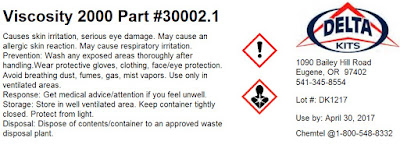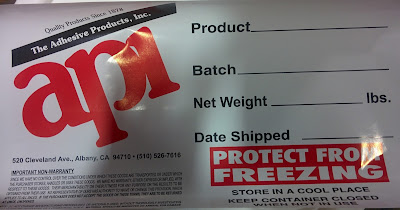 |
| DELTA Kits Example GHS Label |
As with most companies in the chemical and adhesive industries, Delta Kits needed to comply with the international Global Harmonized System of Classification and Labeling of Chemicals (GHS) requirements, implemented in the United States by OSHA (https://www.osha.gov/dsg/hazcom/ghs.html) with the deadline date of June, 2015 (December, 2015 for distributors) https://www.osha.gov/dsg/hazcom/HCSFactsheet.html. David Patterson, Warehouse Manager, for Delta Kits contacted us after a referral from one of our other customers.
One of the label needs David had was to meet dual language requirements for GHS in Canada especially on small bottles: http://www.deltakits.com/shopping/resins/product/87-30290-premium-pit-resin-7-ml-plastic-bottle or syringes http://www.deltakits.com/shopping/resins/product/81-30003-magnibond-resin-one-shot-applicator-pkg-of-5. Based on this requirement, David asked, “Does the TM-C3500 printer have the ability to print on card stock like bottle neckers?” David had the idea of placing slits in a necker to enable the tag to slip over a bottle or around a syringe. Here is his first draft design of a 4” x 1.5” necker.
David’s idea was to use the neckar to add more area for information to meet the GHS requirements for small containers. Plus, he could use the neckars as a means to print in dual languages for shipping; that would make it easy to remove once the product arrived in country. This idea sounded perfect for many of our customers with small containers.
Based on David’s question, my response was, “Yes; however,
it needs to be inkjet coated stock. If you send me exactly the dimensions
(and volumes) of your tag, I can get you a quote. Once you get the TM-C3500
printer, you can try your existing stock. But more than likely it will
not work as thermal transfer card stock is coated; preventing the ink from
drying. If you have a plain paper tag stock, it may work; but the ink may
spread slightly.”
Based on our discussion, David decided to purchase durable 8
mil poly tags with this initial design:
 |
| GHS Tag Design |
We decided to place slits in the hole; and leave the
chad. We needed to leave the chad as the
C3500 uses a vacuum to hold the paper to the printhead. With a hole, the printer could produce bad
print quality or will not work.
When David received the tags, they printed; but not
great. According to David, “I ran a few
tests on the tags. The print did not look so good. I shut off the air to the
area of the hole by closing the shutters on the inside of the front door of the
printer. It helped a little but still did print as well as our labels. Printing
came out blurred.“
 |
| GHS Bottle Tags |
According to David, the blurred print was worse using a
PDF. Based on the feedback, we decided
the hole was causing the issue; especially given the stiffer matte poly; and
opted to try a softer, more conformable material.
Once produced, David again tried this material but found a
different issue. The tag would not read
the black mark and skipped tags; or would not read the blackmark at all.
 |
| GHS Bottle Tags |
With the new feedback, the plant went to work to determine
what was causing the issue. It was soon discovered
that the tags would work, no problem, if the tags were rewound in the opposite
direction.
And now Dave is printing GHS tags that look great!
 |
| GHS Tags |
David Patterson of Delta Kits had a great idea to solve the
issue of adding a lot of information to labels for very small containers. If
you have small bottles or syringes that need to meet the GHS requirements,
contact us about using tags or neckars to provide more real estate for
information. We can help.
Guy Mikel
855-962-7670







